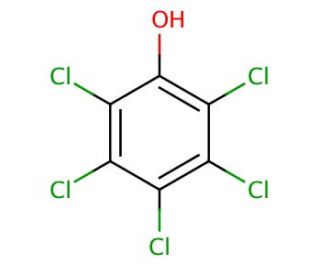

Pentachlorophenol (CAS 87-86-5)
QUICK LINKS
Pentachlorophenol (PCP) is a man-made substance often found as dark gray to brown dust, beads, or flakes, primarily used industrially as a fungicide and wood preservative. Pure Pentachlorophenol forms colorless crystals and is slightly soluble in water, but humans usually encounter the impure form. It is toxic through inhalation, ingestion, and skin absorption, and is classified as a possible carcinogen. Pentachlorophenol′s primary biochemical effect is the active uncoupling of oxidative phosphorylation, inhibiting energy release from ATP breakdown. Exposure can affect the liver, kidneys, and central nervous system, and cause dermatitis and chloracne. It increases cellular oxygen demand, leading to a rise in respiration rate. Laboratory studies suggest it influences genes related to apoptosis, oxidative stress, glutathione metabolism, and mitogenic response.
Pentachlorophenol (CAS 87-86-5) References
- Pentachlorophenol and other chlorinated phenols are substrates for human hydroxysteroid sulfotransferase hSULT2A1. | Gulcan, HO., et al. 2008. Chem Res Toxicol. 21: 1503-8. PMID: 18656962
- Removing pentachlorophenol from water using a nanoscale zero-valent iron/H2O2 system. | Cheng, R., et al. 2015. Chemosphere. 141: 138-43. PMID: 26184790
- Oxidative degradation of pentachlorophenol by permanganate for ISCO application. | Matta, R. and Chiron, S. 2018. Environ Technol. 39: 651-657. PMID: 28317441
- Chloracne from pentachlorophenol-preserved wood. | Cole, GW., et al. 1986. Contact Dermatitis. 15: 164-8. PMID: 2946536
- Mineralization of pentachlorophenol by ferrioxalate-assisted solar photo-Fenton process at mild pH. | Ye, Z., et al. 2019. Chemosphere. 217: 475-482. PMID: 30439659
- Pentachlorophenol-induced cytotoxicity in human erythrocytes: enhanced generation of ROS and RNS, lowered antioxidant power, inhibition of glucose metabolism, and morphological changes. | Maheshwari, N., et al. 2019. Environ Sci Pollut Res Int. 26: 12985-13001. PMID: 30895543
- Pentachlorophenol inhibits CatSper function to compromise progesterone's action on human sperm. | Zhang, X., et al. 2020. Chemosphere. 259: 127493. PMID: 32622245
- 3,4-Dihydroxybenzaldehyde attenuates pentachlorophenol-induced cytotoxicity, DNA damage and collapse of mitochondrial membrane potential in isolated human blood cells. | Maheshwari, N. and Mahmood, R. 2022. Drug Chem Toxicol. 45: 1225-1242. PMID: 32854525
- Ecotoxicological risk assessment of pentachlorophenol, an emerging DBP to plants: evaluation of oxidative stress and antioxidant responses. | Ranjan, J., et al. 2021. Environ Sci Pollut Res Int. 28: 27954-27965. PMID: 33527244
- Pentachlorophenol has significant adverse effects on hematopoietic and immune system development in zebrafish (Danio rerio). | Namit, A., et al. 2022. PLoS One. 17: e0265618. PMID: 35333877
- Concurrent anaerobic chromate bio-reduction and pentachlorophenol bio-degradation in a synthetic aquifer. | Shi, X., et al. 2022. Water Res. 216: 118326. PMID: 35364351
- Toxicity Analysis of Pentachlorophenol Data with a Bioinformatics Tool Set. | Polouliakh, N., et al. 2022. Methods Mol Biol. 2486: 105-125. PMID: 35437721
- Immunotoxicity of pentachlorophenol to a marine bivalve species and potential toxification mechanisms underpinning. | Zhang, W., et al. 2022. J Hazard Mater. 439: 129681. PMID: 36104908
- Complete pentachlorophenol biodegradation in a dual-working electrode bioelectrochemical system: Performance and functional microorganism identification. | Cai, X., et al. 2023. Water Res. 230: 119529. PMID: 36580804
- Pentachlorophenol causes redox imbalance, inhibition of brush border membrane and metabolic enzymes, DNA damage and histological alterations in rat kidney. | Maheshwari, N., et al. 2023. Pestic Biochem Physiol. 190: 105318. PMID: 36740338
Ordering Information
| Product Name | Catalog # | UNIT | Price | Qty | FAVORITES | |
Pentachlorophenol, 1 g | sc-257975 | 1 g | $32.00 |
